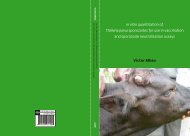Ranking malaria risk factors to guide malaria cont... - ResearchGate
Ranking malaria risk factors to guide malaria cont... - ResearchGate
Ranking malaria risk factors to guide malaria cont... - ResearchGate
You also want an ePaper? Increase the reach of your titles
YUMPU automatically turns print PDFs into web optimized ePapers that Google loves.
Highland Malaria Risk Fac<strong>to</strong>rs<br />
parasite and the human host and (3) human related <strong>fac<strong>to</strong>rs</strong> such as<br />
socio-economic status, health access, migration, gender, <strong>cont</strong>rol<br />
activities (IRS, Insecticide Treated Net, and Intermittent Preventive<br />
Treatment) and land use (irrigation, deforestation, swamp drainage<br />
and living near breeding sites). The conceptual model of potential<br />
<strong>fac<strong>to</strong>rs</strong> influencing either Anopheles (density, longevity or/and <strong>cont</strong>act<br />
with human) or the outcome of transmission (i.e. <strong>malaria</strong> infection)<br />
in the highland based on this review is presented in Figure 1.<br />
Fac<strong>to</strong>rs Influencing Malaria<br />
The ability <strong>to</strong> suppress <strong>malaria</strong> infection depends on immunity.<br />
It has been suggested by Bodker et al [18] that acquired immunity<br />
is both exposure and age-dependent. At a moderate level of<br />
transmission (0.1 <strong>to</strong> 2 infective bites per year), immunity will<br />
develop with increasing transmission but after a certain age (2–3<br />
years) the immunity will increase independently of transmission<br />
intensity. In low transmission areas, however, prevalence of<br />
infection and clinical <strong>malaria</strong> is similar in all age group.<br />
The health status of the population can have an important<br />
impact on <strong>malaria</strong> infection. Malnutrition can weaken children’s<br />
immunity and can increase the level of <strong>malaria</strong> morbidity and<br />
mortality [19,20]. HIV has been associated with an increased level<br />
of <strong>malaria</strong> transmission in South Africa [21] and might enhance<br />
<strong>malaria</strong> parasite biomass [22]. It has also been observed that in all<br />
endemic areas the frequency of <strong>malaria</strong> infection is greater in<br />
pregnant women than in non pregnant women. However in low or<br />
unstable transmission areas, as in the African highlands, the effect<br />
of parity is less pronounced or even absent as compared <strong>to</strong> high<br />
transmission areas [23,24]. Conversely, the implementation of<br />
intermittent preventive treatment is able <strong>to</strong> reduce morbidity in<br />
pregnant women [25] and in infants [26].<br />
In several countries, the resurgence of <strong>malaria</strong> has been largely<br />
attributed <strong>to</strong> the emergence and spread of drug-resistant parasites<br />
[27–31]. The progressive build-up of the game<strong>to</strong>cyte pool in the<br />
human reservoir, <strong>cont</strong>ributing <strong>to</strong> the speed-up of transmission,<br />
could be enhanced by treatment failure of sulphadoxinepyrimethamine<br />
[32] and chloroquine [33]. In <strong>cont</strong>rast, implementation<br />
of effective treatment, such as artemisin-based combination<br />
therapy, has improved cure rates, decreased the game<strong>to</strong>cyte<br />
carriage and, therefore, resulted in a reduced transmission in low<br />
endemic areas [34,35].<br />
Finally, other human related <strong>fac<strong>to</strong>rs</strong>, such as population<br />
migrations [36], reduced health systems access and quality [2],<br />
and socio-economic pressure as population growth [37,38] have<br />
also created favourable conditions for <strong>malaria</strong> outbreaks.<br />
Fac<strong>to</strong>rs Influencing the Vec<strong>to</strong>r<br />
Mosqui<strong>to</strong>s’ longevity, man-vec<strong>to</strong>r <strong>cont</strong>act and mosqui<strong>to</strong> density<br />
determine the transmission capacity of a vec<strong>to</strong>r population. First, a<br />
reduction in the lifespan of the mosqui<strong>to</strong>es will reduce the<br />
sporozoite rate and hence the proportion of infective bites.<br />
Secondly, a reduction in the human/vec<strong>to</strong>r <strong>cont</strong>act will decrease<br />
the proportion of blood meals taken on human hosts. Finally, a<br />
reduction of vec<strong>to</strong>r density by decreasing the number of adult or<br />
larvae will also reduce transmission intensity. Therefore, any<br />
<strong>fac<strong>to</strong>rs</strong> that could have an impact on any of these components will<br />
influence <strong>malaria</strong> transmission. According <strong>to</strong> the MacDonald<br />
model [39], <strong>fac<strong>to</strong>rs</strong> influencing longevity will have more impact on<br />
Figure 1. Conceptual model of important <strong>risk</strong> <strong>fac<strong>to</strong>rs</strong> affecting <strong>malaria</strong> prevalence in the African Highlands. Fac<strong>to</strong>rs are regrouped in 3<br />
main classes (environmental <strong>fac<strong>to</strong>rs</strong>: green label, biological <strong>fac<strong>to</strong>rs</strong>: grey label and human related <strong>fac<strong>to</strong>rs</strong>: blue label). Dependant variables included in<br />
the CART analysis are displayed in red and predic<strong>to</strong>r variables are highlighted in white.<br />
doi:10.1371/journal.pone.0008022.g001<br />
PLoS ONE | www.plosone.org 3 November 2009 | Volume 4 | Issue 11 | e8022











